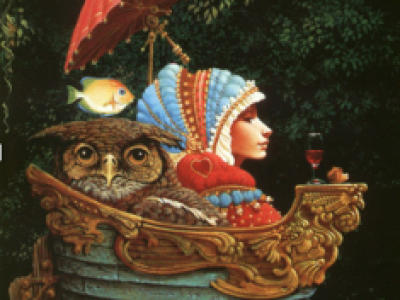Before the play was ever considered, the story of the Mill on the Floss resided within the pages of a book. The author of this book went by the name of George Eliot. But this book was always more than it appeared to be, and its author became well renowned throughout the world.

The novel was written in the early to mid- 19th century, when Queen Victoria was on the throne and the industrial revolution was sinking its teeth deep into the developed world. The name “George Eliot” was actually a ruse. The real name of the author was Mary Anne Evans, a woman who seemed to be very homely in looks, but captivatingly eloquent in her speech and mannerisms. Mill on the Floss was not her only masterpiece – Mary Anne Evans wrote many incredibly popular works of fiction in her day, and they all carried the penname of George Eliot. Evans’ reason for this was simple and yet complex: women were looked down upon for aspiring to "manly" ambitions, like writing. Women were seen as having inferior intellect, and most people would dismiss any female writer and their works as frivolous. However, Evans wanted her work to be seriously considered by everyone, because of the messages that they contained. For a while, this strategy did work: her novels were highly praised throughout all society and became very popular. Eventually, the truth of her gender did come out and many male scholars tried to take back their initial praise of her work, but she was still highly favored within society, and the Queen herself even petitioned Evans for her autograph.

Mill on the Floss, unlike her other works, is unique in that it is a fictional autobiography. What does that mean? In this context it means that while the story itself is fictionalized, there are many parallels to Evans’ own life and experiences. There are many debates among scholars about where exactly all of these parallels are, but I hope to outline a few of them here to help you understand how deeply personal this special novel was to Evans. For example, there’s Maggie’s brother, Tom. Mary Anne Evans also had a brother and his name was Isaac. He was their mother’s favored child, and after Evans decided to live with George Henry Lewes, Isaac disowned her. There are those that speculate that the ending of Mill on the Floss had to do, in part, with Mary Anne Evans’ own desire to reconcile her relationship with her own brother, which sadly never did happen. Many of the similarities had to do with Evans’ own childhood. This included her relationship with her mother. Evans’ mother was never particularly interested in her daughter, and even sent her away to boarding school when she was still quite young. This trait is also adopted within Maggie’s mother, who - Maggie argues - loves her material things more than she loved her children. But Evans’ mother died before she could finish her education, and Evans was forced to return home to take care of the house, her father, and the other ‘womanly duties,’ which Maggie also reflects within the book.

Another parallel is the image that Mary Anne Evans and Maggie both came to represent within society. Mary Anne Evans fell in love with George Henry Lewes when she was still quite young, and he returned her affection in kind. The problem with their relationship, however, was that Lewes was already married to another woman and could not divorce, despite the fact that they were estranged from each other. Evans herself did not seem to mind this fact and spent most of her life with Lewes in an open relationship. At this time, however, that was incredibly scandalous, and much of society ridiculed Evans and Lewes for their relationship. Maggie also ends up with public scorn from society after her time with Stephen Guest. In this, we have a glimpse of what Evans had to deal with through most of her life because of her relationship with Lewes.
This book, in a sense, carries the spirit of Mary Anne Evans within its pages and throughout its plotline. And with this stage adaptation, written by Helen Edmundson, we have more of an opportunity to see and relate to Evans, to understand the messages that she wanted us to take away. It also raises interesting questions to think about. How would you write your personal autobiography? What kind of legacy would you want to leave for future generations to ponder upon? And how does this story, in relation to Mary Anne Evans, relate to all of us today?



